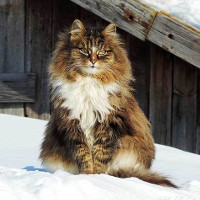 |
Sibérien |
|
TranslationFrancis Vandersteen |
||
OriginThe Sibérien is a breed of cat that originated in Russia. |
| This large cat is characterized by its semi-long-haired coat and barrel-shaped silhouette. |
A brief historical overview |
| The breed probably originated in Transcaucasia and Iran, and arrived with settlers from this area in southern Siberia to settle. The breed thus formed naturally in southern Siberia. The Sibérien cat is renowned for its robust health and accommodating character. The Sibérien cat arrived in North America in 1990, via the Starpoint cattery. Males can weigh from 5 to 10 kg, while females are much smaller, weighing between 3 and 8 kg. In spring, they shed their thick winter coat for a much lighter summer one. |
General appearance |
| These big cats mature slowly, and only finish growing at around three years of age. The guard hair does not develop until six months of age. The Sibérien is the most hypoallergenic of all cat breeds, i.e., it causes few allergies. That's why it can be adapted to people who are normally allergic to cats. The Sibérien naturally produces little of the allergenic protein FEL D1, responsible for allergies in 85% of cat-allergic people. According to statistics obtained from the magazine Taïga (USA), 85% of cat allergy sufferers are allergic to the FEL D1 allergen. |
Behavior / characteristics |
| The Siberian is described as a quiet force, generally with a “dog-cat” character (often in males), very close to its owners if raised in good catteries. They have a gentle personality, get on well with other cats and dogs and become very attached to their owner. They are generally very good companions who enjoy living with their family. There are no major differences in character between males and females. |
Health |
| The Siberian is a hardy breed, meaning that true Siberians rarely fall ill. The Sibérien has two known genetic diseases (if crossed with other breeds): PKD and HCM. Both are detected after the age of two by ultrasound performed by a specialized veterinarian. There is no genetic screening. Vaccination is annual. The frequency with which anti-parasite products (flea and worm) are administered depends on whether or not the cat has access to the outdoors. |
Head |
||
Cranial region |
||
Head |
The broad head is shaped like a rounded triangle. | |
Skull |
Broad, flat skull. | |
Facial region |
||
Forehead |
In profile, the forehead is slightly rounded. A straight profile is considered a fault, as is the presence of a stop. | |
Nose |
The flat nose is medium to short. | |
Muzzle |
The muzzle is round and strong, without pinch, although in females it is often finer. A pointed or narrow muzzle is penalized in cat shows. | |
Cheeks |
Cheekbones neither prominent nor protruding. | |
Eyes |
The eyes are large, almost round, and set wide apart (at least the width of one eye). They are set at a slight angle, without being oriental. All colors are acceptable, except colorpoint, which is blue. | |
Ears |
Medium-sized, broad at the base, rounded at the tip. They are set at a distance equivalent to one to one-and-a-half ear widths. Ears too close together are considered a fault. They point forward. They are covered on the outside with abundant fur that almost completely hides their base. The inside of the ears is also covered with abundant hair. Plumes are appreciated, but not mandatory. | |
Neck |
| The short, round neck is powerfully muscled. |
Body |
||
Generality |
The Sibérien is a large, semi-cobby cat with medium-long to long hair. They give off an impression of strength and gentleness. The body is “barrel-shaped”, i.e. fairly round and massive. This is not a sign of obesity, however: the bones and muscles are well developed. There is a great deal of sexual dimorphism between males and females. Bones should never be thin. | |
Underline and belly |
Powerful abdominal webbing. | |
Tail |
| Bushy, rather broad at the base, tapering to a rounded tip. Folded over the back, the tip of the tail reaches the base of the shoulder blades. |
Limbs |
| The legs are of medium length, powerful and muscular. High legs are a fault in competition. | ||
Forequarters |
Hindquarters |
||
Generality |
The hindquarters are rounded and higher than the forequarters. | |
Feet |
| The feet are large and round, with numerous hairs between the toes. |
Coat |
||
Coat and texture |
The coat is medium-long to long, with a ruff and lots of undercoat (although there are strong seasonal variations, with less hair and shorter in summer). The neck, shoulders and back are covered with thick, glossy guard hairs that form a large frill. On the belly, the hair may curl slightly, but this characteristic is not sought-after. All traditional and colorpoint coats are accepted for all colors except cinnamon, fawn, chocolate and lilac1 , as well as amber. For particolored cats, all proportions of white are accepted, without any specific request concerning the location of white spots. |
|
Color and ticking |
The Siberian breed includes the neva masquerade, a distinction given by this cat's colorpoint coat. The one and only difference between “classic” and “neva masquerade” Siberians lies in coat color. Neva masquerade cats have a light coat with dark tips. Classics, on the other hand, can be any color, just like alley cats. It's perfectly possible to breed nevas with classics. Some breeders of so-called “classic” Siberians dispute the neva masquerade color, although it is accepted by cat associations. |
|






 English (United Kingdom)
English (United Kingdom)